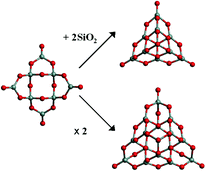Energetics and structures of the initial stages of nucleation of (SiO2)N species: possible routes to highly symmetrical tetrahedral clusters†‡
Abstract
A detailed survey of the low energy isomer

* Corresponding authors
a Departament de Química Física & Centre Especial de Recerca en Química Teòrica, Universitat de Barcelona & Parc Científic de Barcelona, C/Martí i Franquès 1, Barcelona, Spain
A detailed survey of the low energy isomer

 Please wait while we load your content...
Something went wrong. Try again?
Please wait while we load your content...
Something went wrong. Try again?
S. T. Bromley and F. Illas, Phys. Chem. Chem. Phys., 2007, 9, 1078 DOI: 10.1039/B615455G
To request permission to reproduce material from this article, please go to the Copyright Clearance Center request page.
If you are an author contributing to an RSC publication, you do not need to request permission provided correct acknowledgement is given.
If you are the author of this article, you do not need to request permission to reproduce figures and diagrams provided correct acknowledgement is given. If you want to reproduce the whole article in a third-party publication (excluding your thesis/dissertation for which permission is not required) please go to the Copyright Clearance Center request page.
Read more about how to correctly acknowledge RSC content.
 Fetching data from CrossRef.
Fetching data from CrossRef.
This may take some time to load.
Loading related content
